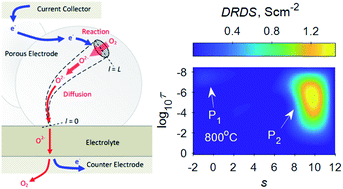In operando monitoring of reaction-diffusion streamlines and uncovering of electrochemo-structural interactions in electrodes†
Abstract
An open question for interpretation of impedance spectra of electrochemical cells is how to decouple the electrochemo-structural interactions. Reduced-dimensional models, such as equivalent circuits, face challenges in capturing the impacts of inhomogeneities (e.g. roughness and constriction effects) in three-dimensional microstructures, where mean-field assumption breaks down. Here we report a new method to analyze the impedance spectra of the reaction-diffusion process in an electrode based on a distribution of reaction-diffusion streamlines (DRDS) connected parallelly with different lengths (representing the roughness effects) and shapes (representing the constriction effects). Demonstrations on (La,Sr)(Co,Fe)O3−δ electrodes show that the DRDS method can explicitly capture the geometric inhomogeneities and the multiple rate-determining steps in the multi-scale features of the electrode microstructure. Furthermore, the kinetic parameters for the reaction-diffusion process can be extracted accurately from the DRDS analysis, and ‘direct three-phase-boundary reactions’, a well-known open hypothesis in solid oxide cells, are monitored clearly by using the DRDS pattern. This method is generally applicable to many electrochemical systems involving a reaction-diffusion process in the electrode.



 Please wait while we load your content...
Please wait while we load your content...